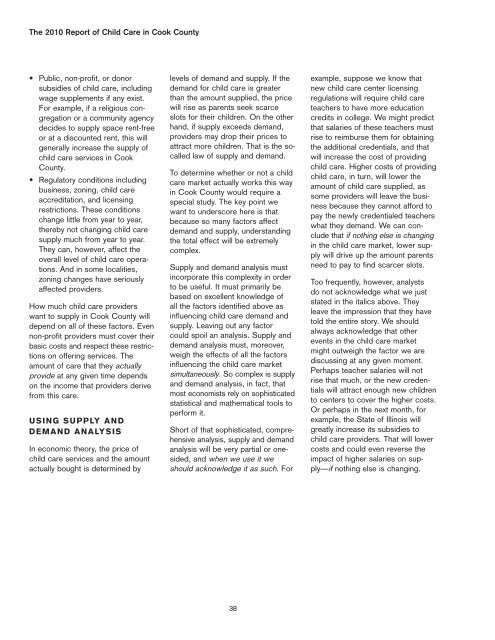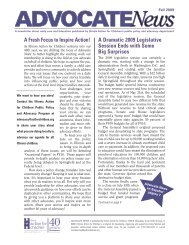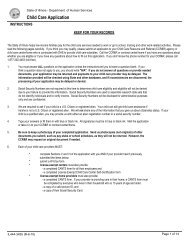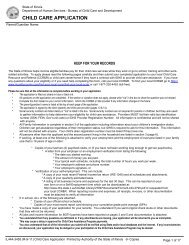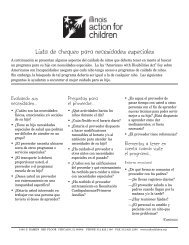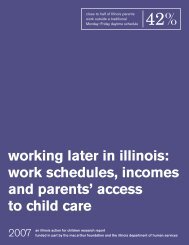A P P E N D I X 2The Demand <strong>for</strong> and Supply ofChild Care—Basic FactorsWHY DEMAND ANDSUPPLY?Many analysts believe that understand<strong>in</strong>gthe demand <strong>for</strong> and supplyof <strong>child</strong> <strong>care</strong> is critical. Withoutsuch knowledge, we can neverknow whether a region such asCook County has enough <strong>child</strong> <strong>care</strong>services. Nor can we understandwhy <strong>child</strong> <strong>care</strong> prices are ris<strong>in</strong>g orwhat the effects of ris<strong>in</strong>g rates are:<strong>for</strong> example, whether ris<strong>in</strong>g pricesprimarily drive work<strong>in</strong>g parents awayfrom us<strong>in</strong>g <strong>child</strong> <strong>care</strong> or primarilyencourage <strong>child</strong> <strong>care</strong> providers toexpand and provide higher quality<strong>care</strong>. F<strong>in</strong>ally, understand<strong>in</strong>g supplyand demand helps us understandways to <strong>in</strong>fluence <strong>child</strong> <strong>care</strong> prices,expand the use of <strong>child</strong> <strong>care</strong> amongwork<strong>in</strong>g parents and improve <strong>child</strong><strong>care</strong> quality. This Appendix discussesthe basic concepts of demand andsupply <strong>in</strong> <strong>child</strong> <strong>care</strong> and shows whyit is so difficult to speak about themauthoritatively.DemandFamilies with <strong>child</strong>ren who want andcan af<strong>for</strong>d to place their <strong>child</strong>ren <strong>in</strong><strong>child</strong> <strong>care</strong> are the source <strong>for</strong> demand<strong>for</strong> <strong>child</strong> <strong>care</strong> <strong>in</strong> Cook County. Theirdemand is simply how much <strong>child</strong><strong>care</strong> services they would buy at ago<strong>in</strong>g price. In general, the size ofthis demand depends upon the num -ber of <strong>child</strong>ren of <strong>child</strong> <strong>care</strong> age <strong>in</strong>those families, from <strong>in</strong>fants to older<strong>child</strong>ren need<strong>in</strong>g be<strong>for</strong>e- or afterschool<strong>care</strong>. Demand also hasdeeper roots <strong>in</strong>clud<strong>in</strong>g these factors:• Whether family <strong>in</strong>comes aresufficient to pay <strong>for</strong> <strong>child</strong> <strong>care</strong>,especially <strong>in</strong> comparison to theprices of other necessities thefamily buys.• Whether families have access to<strong>child</strong> <strong>care</strong> assistance programsto help pay <strong>for</strong> <strong>child</strong> <strong>care</strong> whenthey cannot af<strong>for</strong>d to buy itdirectly. For example, work<strong>in</strong>gfamilies’ access to CCAP s<strong>in</strong>ce1997 has provided a powerfulstimulus to demand <strong>for</strong> <strong>child</strong><strong>care</strong> <strong>in</strong> Ill<strong>in</strong>ois.• Whether parents can af<strong>for</strong>d tostay at home with <strong>child</strong>ren orreceive <strong>in</strong>come from programssuch as the now-term<strong>in</strong>atedAid to Families with Dependent<strong>Children</strong> that allows them torema<strong>in</strong> home with <strong>child</strong>ren.• Whether families have availablesubstitutes to purchas<strong>in</strong>g <strong>child</strong><strong>care</strong>, such as these:• Relatives who can <strong>care</strong> <strong>for</strong><strong>child</strong>ren while parents work.• Alternative <strong>care</strong> that is availableand subsidized (HeadStart, Preschool <strong>for</strong> All, andso on).• Work schedules that allowparents <strong>in</strong> two-parent familiesto share <strong>care</strong>—one car<strong>in</strong>g <strong>for</strong><strong>child</strong>ren while the other works.• Parents’ preferences aboutlett<strong>in</strong>g others <strong>care</strong> <strong>for</strong> their <strong>child</strong>ren.This factor beh<strong>in</strong>d parents’demand often depends on the<strong>child</strong>’s age.• Parents’ perceptions of the qualityof <strong>care</strong> available.How much <strong>child</strong> <strong>care</strong> Cook Countyfamilies will want to purchase dependson all of these factors. With thesefactors <strong>in</strong> the background, theamount of <strong>care</strong> families actuallypurchase and use depends on theprice and availability (or supply) ofthis <strong>care</strong>.SupplyIndividual providers, educators,non-profit enterprises, <strong>for</strong>-profitenterprises, and public agenciessupply <strong>child</strong> <strong>care</strong> services <strong>in</strong> CookCounty by mobiliz<strong>in</strong>g people, facilities,and materials <strong>for</strong> the purposeof car<strong>in</strong>g <strong>for</strong> <strong>child</strong>ren. As Section IIof this Report demonstrates, <strong>child</strong><strong>care</strong> takes a variety of shapesacross Cook County, <strong>in</strong>clud<strong>in</strong>gproviders <strong>in</strong> their own homes, <strong>care</strong>giverswho go to the <strong>child</strong>ren’shomes, non-profit and <strong>for</strong>-profit centers,public and private preschools,after-school programs, and so on.Many <strong>child</strong> <strong>care</strong> program developersand directors also engage diverseagencies that f<strong>in</strong>ance, regulate zon<strong>in</strong>g,license, and accredit <strong>child</strong> <strong>care</strong>.F<strong>in</strong>ally, they recruit <strong>in</strong> labor markets<strong>for</strong> the <strong>child</strong> <strong>care</strong> work<strong>for</strong>ce andcontract with suppliers of goodsand services, such as food, build<strong>in</strong>gma<strong>in</strong>tenance, and books.Child <strong>care</strong> supply is based upon thewill<strong>in</strong>gness and ability of providersto br<strong>in</strong>g people and such resourcestogether given the cost of theresources they need. Among thefactors that we expect to <strong>in</strong>fluencethe supply of <strong>child</strong> <strong>care</strong> services <strong>in</strong>Cook County are the follow<strong>in</strong>g:• The cost of resources such asfacilities, materials, equipment,supplies, overhead, and especiallyemployees.37
The 2010 Report of Child Care <strong>in</strong> Cook County• Public, non-profit, or donorsubsidies of <strong>child</strong> <strong>care</strong>, <strong>in</strong>clud<strong>in</strong>gwage supplements if any exist.For example, if a religious congregationor a community agencydecides to supply space rent-freeor at a discounted rent, this willgenerally <strong>in</strong>crease the supply of<strong>child</strong> <strong>care</strong> services <strong>in</strong> CookCounty.• Regulatory conditions <strong>in</strong>clud<strong>in</strong>gbus<strong>in</strong>ess, zon<strong>in</strong>g, <strong>child</strong> <strong>care</strong>accreditation, and licens<strong>in</strong>grestrictions. These conditionschange little from year to year,thereby not chang<strong>in</strong>g <strong>child</strong> <strong>care</strong>supply much from year to year.They can, however, affect theoverall level of <strong>child</strong> <strong>care</strong> operations.And <strong>in</strong> some localities,zon<strong>in</strong>g changes have seriouslyaffected providers.How much <strong>child</strong> <strong>care</strong> providerswant to supply <strong>in</strong> Cook County willdepend on all of these factors. Evennon-profit providers must cover theirbasic costs and respect these restric -tions on offer<strong>in</strong>g services. Theamount of <strong>care</strong> that they actuallyprovide at any given time dependson the <strong>in</strong>come that providers derivefrom this <strong>care</strong>.USING SUPPLY ANDDEMAND ANALYSISIn economic theory, the price of<strong>child</strong> <strong>care</strong> services and the amountactually bought is determ<strong>in</strong>ed bylevels of demand and supply. If thedemand <strong>for</strong> <strong>child</strong> <strong>care</strong> is greaterthan the amount supplied, the pricewill rise as parents seek scarceslots <strong>for</strong> their <strong>child</strong>ren. On the otherhand, if supply exceeds demand,providers may drop their prices toattract more <strong>child</strong>ren. That is the socalledlaw of supply and demand.To determ<strong>in</strong>e whether or not a <strong>child</strong><strong>care</strong> market actually works this way<strong>in</strong> Cook County would require aspecial study. The key po<strong>in</strong>t wewant to underscore here is thatbecause so many factors affectdemand and supply, understand<strong>in</strong>gthe total effect will be extremelycomplex.Supply and demand analysis must<strong>in</strong>corporate this complexity <strong>in</strong> orderto be useful. It must primarily bebased on excellent knowledge ofall the factors identified above as<strong>in</strong>fluenc<strong>in</strong>g <strong>child</strong> <strong>care</strong> demand andsupply. Leav<strong>in</strong>g out any factorcould spoil an analysis. Supply anddemand analysis must, moreover,weigh the effects of all the factors<strong>in</strong>fluenc<strong>in</strong>g the <strong>child</strong> <strong>care</strong> marketsimultaneously. So complex is supplyand demand analysis, <strong>in</strong> fact, thatmost economists rely on sophisticatedstatistical and mathematical tools toper<strong>for</strong>m it.Short of that sophisticated, comprehensiveanalysis, supply and demandanalysis will be very partial or onesided,and when we use it weshould acknowledge it as such. Forexample, suppose we know thatnew <strong>child</strong> <strong>care</strong> center licens<strong>in</strong>gregulations will require <strong>child</strong> <strong>care</strong>teachers to have more educationcredits <strong>in</strong> college. We might predictthat salaries of these teachers mustrise to reimburse them <strong>for</strong> obta<strong>in</strong><strong>in</strong>gthe additional credentials, and thatwill <strong>in</strong>crease the cost of provid<strong>in</strong>g<strong>child</strong> <strong>care</strong>. Higher costs of provid<strong>in</strong>g<strong>child</strong> <strong>care</strong>, <strong>in</strong> turn, will lower theamount of <strong>child</strong> <strong>care</strong> supplied, assome providers will leave the bus<strong>in</strong>essbecause they cannot af<strong>for</strong>d topay the newly credentialed teacherswhat they demand. We can concludethat if noth<strong>in</strong>g else is chang<strong>in</strong>g<strong>in</strong> the <strong>child</strong> <strong>care</strong> market, lower supplywill drive up the amount parentsneed to pay to f<strong>in</strong>d scarcer slots.Too frequently, however, analystsdo not acknowledge what we juststated <strong>in</strong> the italics above. Theyleave the impression that they havetold the entire story. We shouldalways acknowledge that otherevents <strong>in</strong> the <strong>child</strong> <strong>care</strong> marketmight outweigh the factor we arediscuss<strong>in</strong>g at any given moment.Perhaps teacher salaries will notrise that much, or the new credentialswill attract enough new <strong>child</strong>rento centers to cover the higher costs.Or perhaps <strong>in</strong> the next month, <strong>for</strong>example, the State of Ill<strong>in</strong>ois willgreatly <strong>in</strong>crease its subsidies to<strong>child</strong> <strong>care</strong> providers. That will lowercosts and could even reverse theimpact of higher salaries on supply—ifnoth<strong>in</strong>g else is chang<strong>in</strong>g.38


